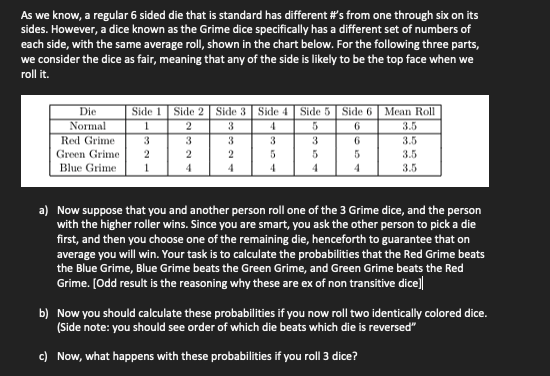As we know, a regular 6 sided die that is standard has different #s from one through six on its sides. However, a dice known as the Grime dice specifically has a different set of numbers of each side, with the same average roll, shown in the chart below. For the following three parts, we consider the dice as fair, meaning that any of the side is likely to be the top face when we roll it. Die Side 1 Side 2 Side 3 Side 4 Side 5 Side 6 Mean Roll Normal 2 3 6. 3.5 Red Grime 3 3 3 3 6 3.5 Green Grime 3.5 Blue Grime 4 4 4 3.5 a) Now suppose that you and another person roll one of the 3 Grime dice, and the person with the higher roller wins. Since you are smart, you ask the other person to pick a die first, and then you choose one of the remaining die, henceforth to guarantee that on average you will win. Your task is to calculate the probabilities that the Red Grime beats the Blue Grime, Blue Grime beats the Green Grime, and Green Grime beats the Red Grime. [Odd result is the reasoning why these are ex of non transitive dice b) Now you should calculate these probabilities if you now roll two identically colored dice. (Side note: you should see order of which die beats which die is reversed" c) Now, what happens with these probabilities if you roll 3 dice?
As we know, a regular 6 sided die that is standard has different #s from one through six on its sides. However, a dice known as the Grime dice specifically has a different set of numbers of each side, with the same average roll, shown in the chart below. For the following three parts, we consider the dice as fair, meaning that any of the side is likely to be the top face when we roll it. Die Side 1 Side 2 Side 3 Side 4 Side 5 Side 6 Mean Roll Normal 2 3 6. 3.5 Red Grime 3 3 3 3 6 3.5 Green Grime 3.5 Blue Grime 4 4 4 3.5 a) Now suppose that you and another person roll one of the 3 Grime dice, and the person with the higher roller wins. Since you are smart, you ask the other person to pick a die first, and then you choose one of the remaining die, henceforth to guarantee that on average you will win. Your task is to calculate the probabilities that the Red Grime beats the Blue Grime, Blue Grime beats the Green Grime, and Green Grime beats the Red Grime. [Odd result is the reasoning why these are ex of non transitive dice b) Now you should calculate these probabilities if you now roll two identically colored dice. (Side note: you should see order of which die beats which die is reversed" c) Now, what happens with these probabilities if you roll 3 dice?
MATLAB: An Introduction with Applications
6th Edition
ISBN:9781119256830
Author:Amos Gilat
Publisher:Amos Gilat
Chapter1: Starting With Matlab
Section: Chapter Questions
Problem 1P
Related questions
Question
Unsure on how to approach this advanced statistics problem

Transcribed Image Text:As we know, a regular 6 sided die that is standard has different #s from one through six on its
sides. However, a dice known as the Grime dice specifically has a different set of numbers of
each side, with the same average roll, shown in the chart below. For the following three parts,
we consider the dice as fair, meaning that any of the side is likely to be the top face when we
roll it.
Die
Side 1
Side 2 Side 3 Side 4 Side 5 Side 6
Mean Roll
Normal
2
3
6.
3.5
Red Grime
3
3
3
3
6
3.5
Green Grime
3.5
Blue Grime
4
4
3.5
a) Now suppose that you and another person roll one of the 3 Grime dice, and the person
with the higher roller wins. Since you are smart, you ask the other person to pick a die
first, and then you choose one of the remaining die, henceforth to guarantee that on
average you will win. Your task is to calculate the probabilities that the Red Grime beats
the Blue Grime, Blue Grime beats the Green Grime, and Green Grime beats the Red
Grime. [Odd result is the reasoning why these are ex of non transitive dice
b) Now you should calculate these probabilities if you now roll two identically colored dice.
(Side note: you should see order of which die beats which die is reversed"
c) Now, what happens with these probabilities if you roll 3 dice?
Expert Solution
This question has been solved!
Explore an expertly crafted, step-by-step solution for a thorough understanding of key concepts.
Step by step
Solved in 3 steps with 3 images

Recommended textbooks for you

MATLAB: An Introduction with Applications
Statistics
ISBN:
9781119256830
Author:
Amos Gilat
Publisher:
John Wiley & Sons Inc

Probability and Statistics for Engineering and th…
Statistics
ISBN:
9781305251809
Author:
Jay L. Devore
Publisher:
Cengage Learning

Statistics for The Behavioral Sciences (MindTap C…
Statistics
ISBN:
9781305504912
Author:
Frederick J Gravetter, Larry B. Wallnau
Publisher:
Cengage Learning

MATLAB: An Introduction with Applications
Statistics
ISBN:
9781119256830
Author:
Amos Gilat
Publisher:
John Wiley & Sons Inc

Probability and Statistics for Engineering and th…
Statistics
ISBN:
9781305251809
Author:
Jay L. Devore
Publisher:
Cengage Learning

Statistics for The Behavioral Sciences (MindTap C…
Statistics
ISBN:
9781305504912
Author:
Frederick J Gravetter, Larry B. Wallnau
Publisher:
Cengage Learning

Elementary Statistics: Picturing the World (7th E…
Statistics
ISBN:
9780134683416
Author:
Ron Larson, Betsy Farber
Publisher:
PEARSON

The Basic Practice of Statistics
Statistics
ISBN:
9781319042578
Author:
David S. Moore, William I. Notz, Michael A. Fligner
Publisher:
W. H. Freeman

Introduction to the Practice of Statistics
Statistics
ISBN:
9781319013387
Author:
David S. Moore, George P. McCabe, Bruce A. Craig
Publisher:
W. H. Freeman